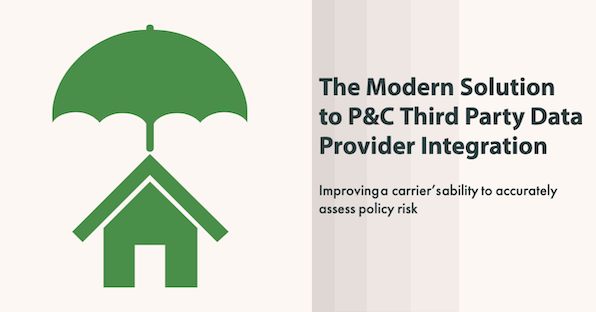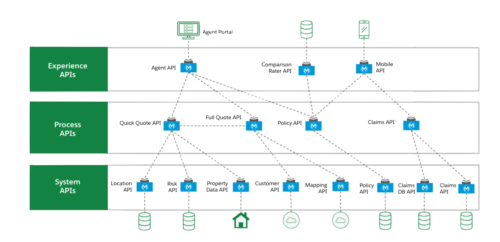The Modern Solution to P&C Third Party Data Provider Integration

The Importance of Data To P&C Insurance Carriers
To evaluate the risk of writing a new policy on a property, insurers rely on a vast array of third-party data providers that supply information on important factors like flood risk, replacement cost estimation, potential liabilities like swimming pools, policyholder creditworthiness, and the likelihood of catastrophic events like hurricanes. With a rapidly growing pool of new data providers, the number of data points that can be mixed and matched to increase a carrier’s ability to accurately assess policy risk is growing by the day.
Proper estimation of risk is a make-or-break proposition for an insurance carrier since it directly impacts the carrier rating, overall profitability, and long-term financial stability. Carriers who underwrite policies with poor risk-to-premium ratios don’t stay in business for long; on the other hand, carriers who invest in a data strategy that allows them to be nimble and leverage risk data to its fullest advantage have a clear leg up on their competition. The evolving availability of data provides a tremendous opportunity for carriers to not only upgrade their ability to estimate risk but also to harness data to detect fraudulent claims, identify risk of policyholder attrition before it happens, surface customer insights, and handle nearly limitless other scenarios.
The ability to properly leverage this data is of the utmost importance to carriers. Unfortunately, carriers are held back by legacy integration approaches that prevent them from maximizing the impact of this data on their bottom lines.
The Traditional Integration Approach
Carriers have been using third-party data to automate portions of the underwriting and risk assessment process for over a decade by wiring services like Melissa Data, Core Logic, and LexisNexis directly into their policy management systems (PMS). The PMS is a monolithic center of the universe in this approach, handling connectivity to the third party providers, aggregating data, applying business logic, and remediating any errors that occur within the transaction before ultimately leveraging the data for its purpose.
In the example below, the Duck Creek PMS consumes data from five different third-party providers and uses custom-developed code to implement the necessary logic within the PMS:

Please note that Duck Creek was chosen for this example and this problem exists for all other policy management systems such as Guidewire.
This approach silos application and business logic within customizations that live on the Duck Creek PMS. It has several pitfalls from a technology perspective that hamstring business initiatives to more effectively use this data:
- Critical business logic is siloed and not reusable to other consumers like additional policy management systems, customer-facing portals, or third-party comparative raters, meaning this logic would need to be written, maintained, and governed for each of these additional consumers.
- Replacing or augmenting a problematic provider results in an IT project that is developer-intensive, slow to market, and costly with an outage risk to the mission-critical PMS.
- Monitoring and problem determination are challenging, error-prone, and time-consuming since they involve custom code that lives on the policy management system.
- Legacy third-party data providers have cumbersome interfaces that are difficult to integrate with and troubleshoot, resulting in one-off spaghetti code.
- No ability to scale services independently based on throughput needs since they live within a monolithic policy administration system.
- Much greater barrier to entry to adding new best-of-breed 3rd party data providers.
- Decreased ability to intelligently cache and meter pay-per-use 3rd party APIs, resulting in increased spending with these vendors.
These pitfalls result in a severe challenge for carriers looking to leverage available data for making the best business decisions. Because this approach is how things have always been done at most carriers, their mindsets have been molded to believe that this is simply the way things are and that they must live with it. But there is a better way to handle managing these integrations that allow carriers maximum agility, reuse, and speed to market while also mitigating outage risk to the PMS.
The Modern Approach: API-led Integration
The API-led approach to integration is just what the doctor ordered for solving this technology challenge and fueling the next level of intelligent data usage at carriers. API-led Connectivity decouples integration logic from the policy management system, alleviating the challenges with the legacy approach.

The result is a solution that allows carriers to move much more quickly in replacing or adding new data providers without outage risk, simplifying a very complex and costly scenario:
- Changing or adding additional 3rd party data providers becomes much less costly and faster without the outage risk to the PMS of the legacy integration approach.
- Business and application logic becomes reusable to other consumers like additional policy management systems, external comparative raters, and policyholder portals.
- Robust data monitoring and problem determination capabilities allow IT to rapidly identify and remediate production issues.
- Each service can be independently scaled to handle its own unique needs.
- New best-of-breed providers can be added and incorporated into the architecture quickly.
- Increased governance and metering of pay-per-use data providers.
- Full ownership and control of data
- Increased ability to rapidly scale new product lines and regions
Closeout
As technology continues to evolve with new InsureTechs emerging daily, the need for insurance IT organizations to be nimble and give themselves the ability to leverage best-of-breed data will continue to become more critical to remain competitive. Legacy approaches to integration of these data providers have saddled carriers with IT infrastructure that is slow to adapt, costly, rigid, and poses needless outage risk to mission-critical, revenue-driving policy management systems. API-led connectivity solves the problems posed by this legacy architecture in an elegant way, giving carriers the tools they need to succeed in today’s data-driven landscape.
Need help modernizing your integration strategy? Want to learn more about how API-lead connectivity helps your business? Contact us to start the conversation.
